|
4/26/2024 Following The Past to Where It Leads MeFollow the people from the past, the places they lived, worked, politics, public sentiment, changing landscape, and a narrative emerges that's worth telling in fiction. While climbing the viewing tower on Mount Constitution in Washington State, I had the opportunity to read the testimony of the men who built it and was hooked on their story. A particular sign caught my eye. It was a certificate of appreciation to one of the men who helped build the tower in 1936, thanking him for being part of an "Army of Youth and Peace" and "Awakening the People to Conservation and Recreation." The men who built the Mt. Constitution viewing tower and much of the infrastructure at the park, served in the U.S. Tree Army, a.k.a the Civilian Conservation Corps. (CCC). They led ordinary lives during an extraordinary time in U.S. history: the Great Depression. These men, recruited from cities, rural towns and Indian Reservations from 1933-1939, served the U.S. citizenry and had an enormous impact on cultural attitudes toward conserving the natural resources, especially National and State forests. Their nickname: The Tree Army, is apt; estimates are they collectively planted over three billion trees across the country. They fought numerous forest fires ravaging lands that were cut over and neglected by private lumber companies, and they prevented the decimation of the Great Plains agricultural lands through their soil conservation works. And they were paid $30.00/month and given three meals a day to do so. The rest, $25.00, was sent home to support their families. Five dollars a month may sound like a paltry sum, but during the Depression, it was a king's salary to these men. "Five dollars a month made me rich! I never had $5.00 before in my life." They were between the ages of 17-30. Some were World War I veterans. All were on public assistance. The U.S. Surgeon General estimated that 75% of the 100,000 men they examined in one year, were malnourished, prone to disease and exhausted from stress and the search for work. As one CCC alum wrote, the men had the mark of shattered ambitions and blasted hopes written on their faces. Although the CCC was touted as a jobs recovery program, and a way to keep men, particularly immigrants from roaming city streets looking for work, President Franklin Roosevelt also had a keen interest in preserving national park land. During his administration the Federal government acquired vast amounts of land and put it in the public domain. Soon, CCC camps were popping up in rural enclaves throughout the U.S. where there were plenty of public work projects to be done. Besides planting trees these men built roads, cabins, lodges, rest areas, bridges, and scenic byways in the parks. And their presence played a big role in improving the economies of the surrounding towns. Local supplies, carpenters, and tradesmen were employed to help build and service the CCC camps and the local businesses: theaters, barbershops, food stores, all catered to them. The Tree Army had an enormous impact on the recreation and tourist industry. Back in 1930 the Great Smoky Mountains National Park had about three thousand visitors a year. By the end of that decade, and due to their work, over 130 thousand visitors came to visit. Today the park welcomes over ten million visitors/year. While reading the testimony of the men in various written accounts, one can imagine how hard it was, especially for the city dwellers, to be sent into the woods, so far from home, even if they were surrounded by awe-inspiring beauty. Most didn't have a high school education and had never traveled outside their own city neighborhoods. One man stated he and the other recruits were pensive when they landed at a Washington port to be shipped out to the San Juan Islands. They didn't believe it when they were told by their camp leader the Islands were part of the United States, instead thinking they were being deported. When Orson Welles broadcast the War of the Worlds on radio in 1938, some of the men panicked, believing their homes in the Northeast were being destroyed by an invasion of martians. As one alum recounted, the boys from the east coast cities were screamin' and hollerin' around the camp. After reading about the men in the CCC, I went looking for fictional accounts and didn't find many. That's when I decided it was time to tell their stories. In April 2022, The Truth of Who You Are was published by Black Rose Writing. A coming of age story about hope and resilience and set at one of the CCC camps in the Smoky Mountains NP. Sources:
Olympic Mountain Range from Mt. Constitution, Moran State Park, Orcas Island. Photo credit Wikimedia: Lee317 Brinkley, Douglas. Rightful Heritage. HarperCollins 2016. Hill, Edwin. In The Shadow of the Mountain. Washington State University Press 1990. Jolley, Dr. Harley. The Maginficent Army of Youth and Peace. UNC Press. 2007. Maher, Neil. Nature's New Deal. Oxford University Press 2009. 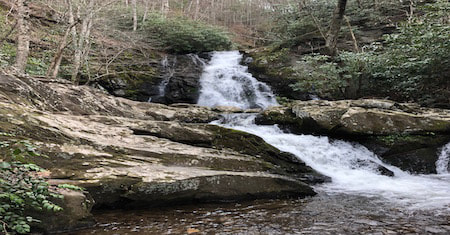 The sound of a stream plunging over a precipice is one sign of spring and on my recent visit to the Smoky Mountains National Park there were plenty of gushing waterfalls; I hiked up to Spruce Flats to get this view. 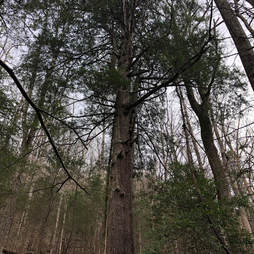 I went to the Smoky Mountains National Park to conduct research for a novel and to write about place, exploring the mountains in spring. I was especially interested in the area around the Tremont Institute in the park. It was once a thriving lumber community and one of the more famous inhabitants was William Walker. He owned most of Walker Valley before the Smoky Mountains National Park was formed, and this is where my fictional family lives. What drew me to their story is the old growth, or what is left of it at the Tremont Institute in the park. William Walker settled here in the 1850s and as lumber operations closed in on his valley, he tried to keep his old growth woods from the clutches of the Little River Lumber Company. William lived a colorful life. According to his descendants, he had three wives and some estimate he sired over 20 children. He hung on to his land until 1918, selling it off to the owner of the Little River Co. on his death bed with the understanding that the old trees would be spared. What he never knew was that eventually his trees were cut, post-mortem, by the company and that he was under paid for the land. A few miles down the road from Tremont and Walker Valley is the only cultural heritage site in the park - Cades Cove. This eleven mile circuit holds what remains of an entire community that once lived there: homes, corn cribs, barns, smoke and spring houses. The people that lived in Cades Cove had full, industrious lives. 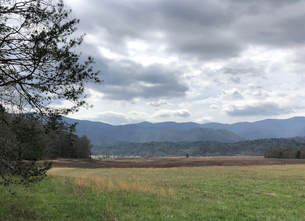 A cove is another name for valley. Large area of flat land between mountains. A cove is another name for valley. Large area of flat land between mountains. Their economy was based on a bartering system with the nearby cities and towns. And they had plenty to barter before the woods were ravaged by blight, forest fire, and habitat destruction. Ginseng, chestnuts, corn, and cattle were just some of the products the people of Cades Cove bartered and sold at markets in Maryville and Knoxville, TN. Luckily local residents (many descendants) from nearby Townsend, Tennessee advocated for preserving the architecture of Cades Cove. It is the only area in the park where you can find everything intact. Which was fortunate because when the government started acquiring land for the park in the mid-1920s they tore down or let buildings rot after their occupants moved out. Just like the natural areas in the park, Cades Cove is a great place to rocket the imagination. I also found a plethora of reading material at the Smoky Mountains Heritage Museum in Townsend, first hand accounts from people who grew up in the region before their families were forced to move because of the National Park in the mid 1930s. These books are gold mines of information, tall tales, and stories about the families who lived there, their hardships, feuds, and industry. Before a fungus blighted the Chestnut trees, children would go deep into the woods to collect the nuts and sell them at the local stores. They had a miller who came in from the fields at the sound of a bell to mill corn for customers who stopped in with a sack of kernels. His was an important job as corn was a family staple and wheat was hard to grow so flour was usually shipped in and store bought. The families raised pigs, notched their ears to identify them and let them roam the hills. At harvest time they were lured in with salt and nuts. The meat was kept in a smokehouse and slabs taken off throughout the winter. Game was scarce by the early 20th century due to over hunting. Hunters were lucky to get a 'Gobbler' roosting in a tree, or squirrel meat. I found no references for deer hunting but Elk now pasture in the coves and there are signs everywhere to be aware of them while driving. I've visited the park twice and have yet to see one. But I'll be back for the next season: summer and maybe I'll get lucky. Connect here for my next post on the history of lumber industry in the Smoky Mountain region.
1/30/2020 The Anatomy of a Historical Novel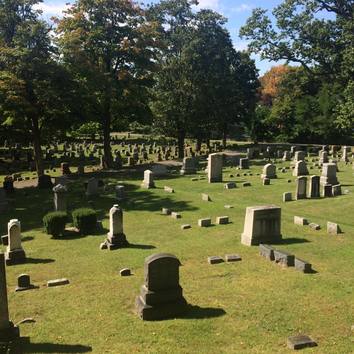 Fort Hill Cemetery, Auburn NY Fort Hill Cemetery, Auburn NY Often, when I'm giving a talk about my novels I'm asked, where did you come up with the idea to write the story? I get my inspiration from past. I started to research the Durant family saga - after staying in a cabin hidden in the wilderness that was supposedly built by William West Durant for trysts with his mistress. What I thought would be a one book love story/romance, turned into a four year research journey. This folklore about William and his mistress started me down a path of clues that shed light on the lives of the Durant family and had me visiting the New York Public Library, the Library of Congress, Winterthur Museum, the Adirondack Museum, and England. My one book idea turned into a trilogy. Soon after I was finished with my draft of novel three in the trilogy, I was visiting my family in South Carolina and ended up hiking in the Great Smoky Mountains, one the US most popular National Park. I was intrigued with the history of the people who once lived in the park and were eventually forced out--like the residents of Cades Cove--now a Cultural Heritage site in the park. And then there is the story of the Walker Sisters, who, due to their age, were allowed to stay in their cabins until they died. I found fascinating oral histories about the former residents in the bookstore of the Smoky Mountains Cultural Heritage Museum in Townsend, TN. While the research is a slow and steady task, never really ending, a lot of it can be done via use of digital archival material. However, the writing takes dedication. I'm lucky enough to be in an academic profession that allows me chunks of time to write. In the summer months I spend the mornings in a library or coffee house writing until I reach 3k words (usually about two-three hours). I do this until I have a rough draft of a novel - about 80k words. Editing takes another year if not more. Indeed, I am still editing the novel I wrote set in the Great Smoky Mountains, The Truth of Who You Are, as it is now out on submission with publishers. Once in a while I panic, thinking, will I ever run out of ideas on what to write about? What if this novel is my last? Can I keep up with the research and the creative process involved in putting out a novel set in the past about real people and events? Recently, while walking in the famous Fort Hill Cemetery in Auburn, NY where Harriet Tubman, and William Seward are buried, I thought about how many stories there are to tell and thought, "I'll ever run out of material." |
AuthorSheila Myers is an award winning author and Professor at a small college in Upstate NY. She enjoys writing, swimming in lakes, and walking in nature. Not always in that order. Archives
April 2024
CategoriesAll Adirondacks Algonquin Appalachia Award Cades Cove Canada Chestnut Trees Christmas Civilian Conservation Corps Collis P. Huntington Creativity Doc Durant Durant Family Saga Emma Bell Miles Finger Lakes Great Depression Hell On Wheels Historical Fiction History Horace Kephart Imagination National Parks Nature Publishing Review Screenplay Short Story Smoky Mountains Snow Storm Stone Canoe Literary Magazine Thomas Durant Timber Wilderness World War II Writing |
|
|
All materials Copyright 2022
Any reproduction, reprint or publication without written consent of author prohibited. |
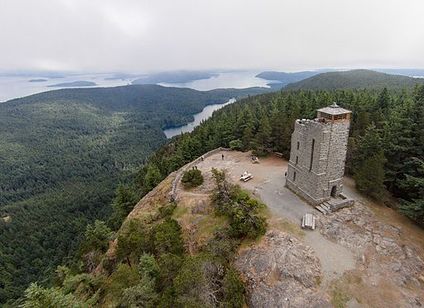
 RSS Feed
RSS Feed